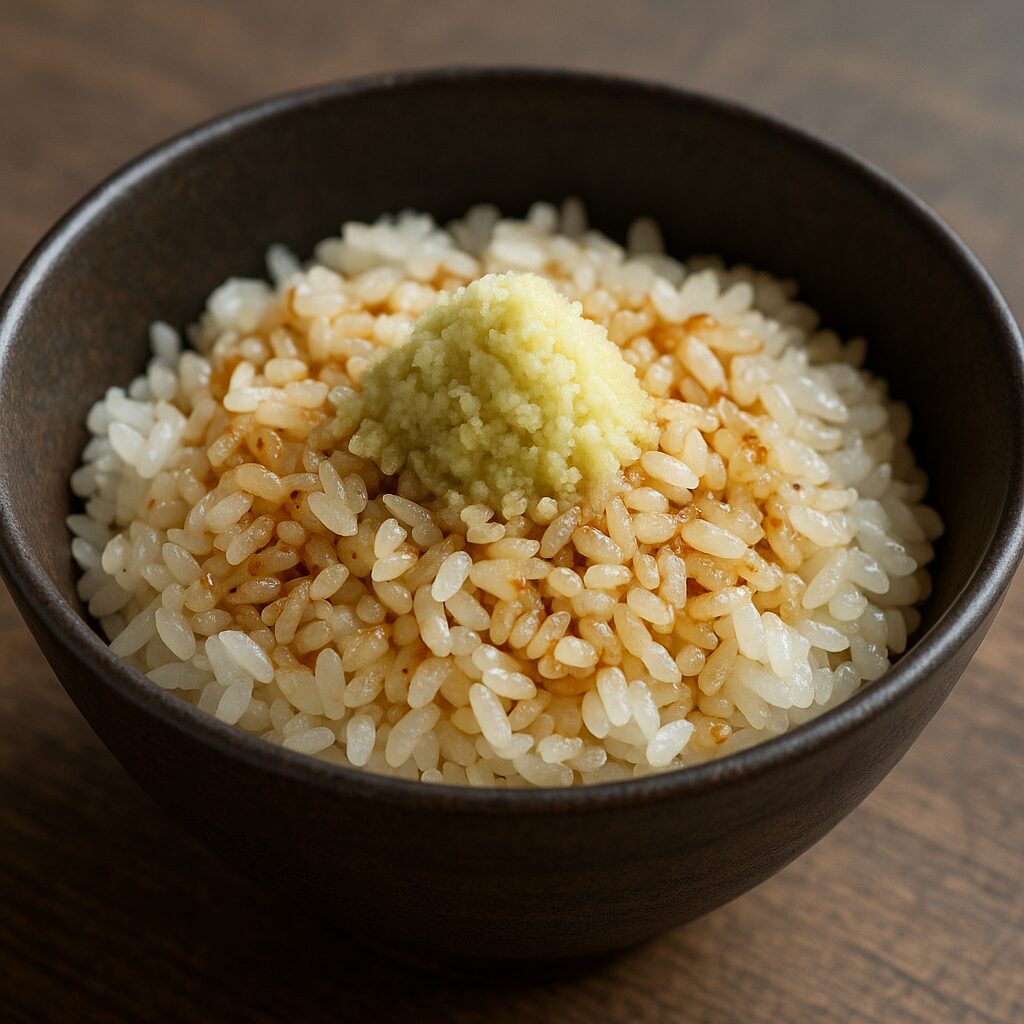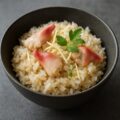山わさび飯の特徴
北海道の食文化
山わさび飯は、北海道特産の山わさび(ホースラディッシュ)をすりおろしてご飯にのせ、醤油をかけて食べる素朴な料理です。ツンとくる辛味と香りが特徴で、シンプルながら食欲をそそります。
保存性の高い調味料
山わさびは冷涼な気候で育ち、保存性が高いため、昔から北海道の家庭で常備されてきました。
シンプルながら奥深い味わい
温かいご飯にのせると香りが立ち、冷たいご飯にのせても爽やかな風味が楽しめます。醤油や出汁醤油と合わせるのが一般的です。
山わさび飯のレシピ
材料(2人分)
- ご飯 … 400g(2膳分)
- 山わさび … 適量(約20〜30g)
- 醤油 … 適量
作り方
- 山わさびを皮をむき、すりおろす。
- 温かいご飯を茶碗によそい、山わさびをのせる。
- 醤油をかけ、よく混ぜながら食べる。
本ワサビではなく、ホースラディッシュの為、旨味と香りが少々物足りないですね。なので、醤油をだし醤油にする・鰹節やふりかけなどをトッピングして旨味を補強するのが良いです。
山わさび飯の栄養価(1人分の目安)
- エネルギー:約250〜300 kcal
- たんぱく質:4〜6 g
- 脂質:1 g以下
- 炭水化物:55〜65 g(ご飯由来)
- ビタミンC:抗酸化作用や免疫力アップに寄与
- 辛味成分(イソチオシアネート):食欲増進や抗菌作用
低脂肪でヘルシーなご飯料理ですが、辛味が強いため量は調整が必要です。
山わさび飯の歴史
北海道開拓時代からの食文化
山わさびは開拓時代に北海道に持ち込まれ、寒冷な土地でもよく育ったため広く栽培されるようになりました。
家庭料理としての普及
保存が利き、安価で食卓にのぼることから、庶民的な料理として定着しました。
現代
現在ではご飯だけでなく、蕎麦や刺身、ステーキの薬味としても用いられ、北海道グルメの代表的な食材のひとつになっています。
English Version
Features of Yamawasabi Rice
A Culinary Tradition of Hokkaido
Yamawasabi rice is a simple dish where freshly grated horseradish (yamawasabi), a Hokkaido specialty, is placed on rice and seasoned with soy sauce. Its sharp pungency and aroma make it appetizing despite its simplicity.
Preservable Ingredient
Horseradish grows well in Hokkaido’s cool climate and has long been valued as a storable condiment in local households.
Simple yet Flavorful
When added to warm rice, its aroma intensifies; when added to cold rice, it gives a refreshing flavor. It is commonly paired with soy sauce or dashi-seasoned soy sauce.
Recipe
Ingredients (for 2 servings)
- Cooked rice … 400g (2 bowls)
- Yamawasabi (horseradish) … 20–30g
- Soy sauce … to taste
Instructions
- Peel and grate the yamawasabi.
- Serve warm rice in bowls and top with yamawasabi.
- Add soy sauce and mix before eating.
Nutritional Value (per serving, approx.)
- Calories: 250–300 kcal
- Protein: 4–6 g
- Fat: less than 1 g
- Carbohydrates: 55–65 g (from rice)
- Vitamin C: supports immunity and antioxidant function
- Isothiocyanates: pungent compounds that aid digestion and have antibacterial effects
A healthy, low-fat rice dish, but its pungency requires moderation.
Historical Background
Since the Hokkaido Pioneering Era
Horseradish was introduced during the pioneering period of Hokkaido. It adapted well to the cold climate, leading to widespread cultivation.
Spread as Home Cooking
Its storability and low cost made it a staple in households, valued for everyday meals.
Modern Day
Today, yamawasabi is used not only on rice but also as a condiment for soba, sashimi, and steak, making it one of Hokkaido’s iconic ingredients.



何でも質問してください!